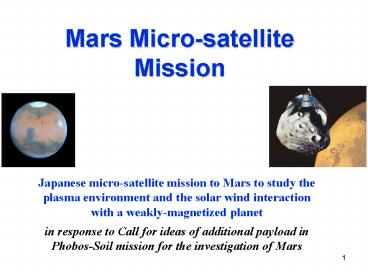Mars Microsatellite Mission - PowerPoint PPT Presentation
1 / 8
Title:
Mars Microsatellite Mission
Description:
Inclination TBD (depends on the orbit control ability) Preferable a mid-inclination orbit for the crustal magnetic field observation ... – PowerPoint PPT presentation
Number of Views:82
Avg rating:3.0/5.0
Title: Mars Microsatellite Mission
1
Mars Micro-satellite Mission
- Japanese micro-satellite mission to Mars to study
the plasma environment and the solar wind
interaction with a weakly-magnetized planet - in response to Call for ideas of additional
payload in Phobos-Soil mission for the
investigation of Mars
2
Motivation
- Nozomi (Japanese Mars Orbiter) had to give up its
injection into orbit around Mars due to
unrecoverable malfunction. - No other spacecraft has performed the original
scientific objectives of Nozomi. Therefore,
numerous scientific questions are still
unresolved.
- Recent discoveries of water on Mars surface
increase our interest in the atmospheric
evolution and the loss process. - Existence of the crustal magnetic field provides
a unique situation of the space plasma phenomena.
3
Mission Scenario
- A micro-satellite for Mars orbiter will be
developed in Japan so that it can fit for the
additional payload zone on Phobos main bus.
- After arriving at Mars, the micro-satellite will
be separated from the mother ship at the Martian
orbit, and it starts observing the upper
atmosphere, ionosphere and the interaction region
with the solar wind.
4
Scientific Objectives - 1
- The solar wind interaction with mini
magnetosphere - The interaction with a weakly-magnetized planet
- Reconnection, particle acceleration
- Magnetospheric convection
- Induced atmospheric escape
- Atmospheric (plasma) escape
- Potential influence on the atmospheric
evolution - Comparative study with the escape from Earth
- Diversity of the escape process and the flux
variation - Where did the atmospheric particle go?
5
Scientific Objectives - 2
- Dynamics and structure of the ionosphere
- Potential role of the crustal magnetic field
- Altitude profile of Ne and Ni, and a role of the
heat flux - Hole, cloud, streamer, tail ray exist?
- Ion pickup and magnetotail
- Quantitative measurement of pickup ions
- Asymmetric distribution of energetic ions and
the ionospheric plasma - Acceleration of escaping ions in the
magnetotail - Ionopause
- Pressure balance
- Momentum transfer and convection
- Role of plasma wave in the mass loading
- Turbulence, K-H instability
6
Scientific instruments
7
Core Institute and Member
8
Spacecraft configuration and orbit
- Planned Orbit (To be revised)
- Elliptical orbit (lt4000 km x 80000 km from Mars
center) Preferable to reduce the periapsis height
below 300 km for the observation of Mars
ionosphere - Inclination TBD (depends on the orbit control
ability) Preferable a mid-inclination orbit for
the crustal magnetic field observation - Mission life gt 1 Mars year
- Baseline Configuration (To be revised)
- Spinning platform
- Control system for orbit and attitude maneuvers
- Telemetry link with mother spacecraft by
omni-directional antenna (Downlink via main bus) - Two booms for magnetometer and thermal plasma
measurement - Two pairs of antenna for plasma wave measurement































